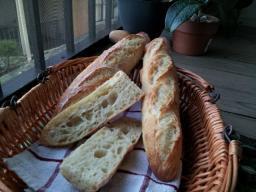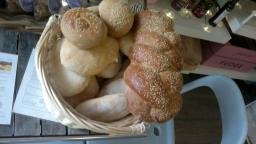
Chad Robertson's Tartine Bread book has been getting a lot of attention on this forum of late so I decided to order a copy and see what it was all about. Mr Robertson's description of his journey to create the bread he had in his mind is a fascinating read and speaks to the dedication he has for his craft. While the book doesn't get into the same level of technical detail as Hamelman's 'Bread', it doesn't suffer for lack of clear and precise instruction, making it accessible to anyone interested in producing fine hand crafted breads, croissants, and brioche. Included is a chapter on various ways to use day old bread, which in itself is worth buying the book for, and one of the best collection of recipes I've seen for quite some time. Eric Wolfinger's excellent photography is found throughout the pages and adds significantly to the overall high quality of this book.
Chapter 1-Basic Country Bread describes in detail Mr Robertson's foundation formula and procedure for making the bread upon which all his other breads are based. Out of respect for copyright I wont share the formula here , but as Mr Robertson says, it is a simple process , and the formula is that of a basic levain style dough. It seems that this past weekend a few other TFL'rs decided to make this bread as well, notably David Snyder, who had wonderful results using Chad Robertson's technique of baking the bread in a dutch oven. http://www.thefreshloaf.com/node/20473/basic-country-bread-quottartine-breadquot-baked-dutch-ovens
Never having used a pot for baking a loaf, I was intrigued by the photos in the book of the dark bold bake that this method can achieve, but as the recipe makes two loaves I decided to bake one in the pot and the other on the stone using Sylvia's method of steaming that's been so successful for her and other TFL members. I made the dough up by hand giving it a 45 minute autolyse and then a 3hr bulk ferment following the guidelines in the book for folding in the bowl, a technique I appreciate because of it's easy cleanup. The dough was divided into 955 gram portions, lightly rounded and rested for 20 minutes before final molding, then placed in floured bannetons for an overnight rise in the refrigerator. I would have liked to have done it all in one day but it was a 'work night' so my time was limited. After 19hrs of final cold rise the first loaf was slashed and placed in the lid of the dutch oven with a round of parchment beneath it, and the pot was placed on top of that. I thought this way would be easier than lowering the loaf into the pot with a lot of extra and unnecessary parchment paper. The oven and pot had been preheated to 500F for a good 40 minutes before the bake began, then turned down to 450F for the remainder of the 45 minute bake.
After 20 minutes the pot was lifted very carefully off the loaf and the loaf continued it's bake, finishing the crust and taking on a rich brown colour.


When the first loaf began it's bake I took the second one out of the fridge and let it warm up on top of the oven, so that by the time the first was out and my stone had heated for the second bake it was ready to go. Into the oven it went with Sylvia's towel steaming method in place and the vent blocked. I gave it as much steam as I possibly could during the first 10 minutes, spritzing regularly in 3-4 minute intervals. It didn't result in quite the jump that #1 had but it did bloom nicely along the slashes creating the type of pattern I've been trying to get on some previous bakes of other levain style breads.

Even with an 8 minute longer bake than #1 it just didn't take on the same kind of caramelization as the pot baked loaf. Still, I was happy with both results and I think both methods have their place depending on what your preferences are for a particular type of loaf. I'm not sure I'd use the pot with anything other than a very lean formula, as I think you might just get a little more colour than you were bargaining for, but for the Tartine basic Country Bread, and similar lean levain style breads it's a method I'll continue using.
Recently my wife Marie hinted that I might be getting a new mixer under the tree this year for Christmas since my KA is getting pretty long in the tooth, so to speak. Now I love new toys as much or even more than next person, so she was a little shocked when I told her that I've decided to start mixing bread by hand as often as possible from now on. It just makes sense to me that the breads that many of us are trying to emulate, are breads that have been around since long before the electric mixer appeared on the scene. I realize it's possible to mix these 'craft/artisan' breads with a mixer by controlling speed and mixing time, but for home baking it's become apparent to me that it's much more practical, and in most ways more satisfying to use the two best mixers I came equipped with. If I had any doubts about making this change they were put to rest when I cut into loaf #1.


This is the type of crumb that I want for my wheat based levain breads.... not exactly, but closer than I've come previously, which I think is due largely to the fact that this dough was worked even less intensively than I would normally do by hand. Why it took me so long to connect the dots that have been staring me in the face all this time, I believe is due to having been trained on mixers, and having used them throughout my professional career for bread mixing. Just goes to show that in baking, the learning never stops if you keep an open mind to the new ideas.. as well as the ancient tried and true methods of bread production.
Best Wishes,
Franko












